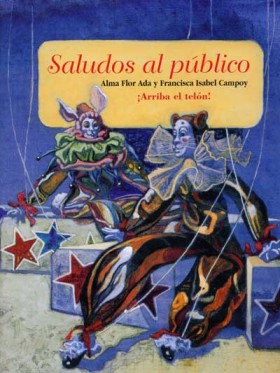
BOOK DESCRIPTION
This theatre anthology includes five plays. Two original plays by F. Isabel Campoy: Busco un socio para mi negocio and Amistad, divino tesoro. The play Los dos hermanos is a dramatization of a traditional Jewish tale, by Alma Flor Ada and F. Isabel Campoy. La cena de tío tigre is a play by Clara Rosa Otero, based on a traditional folktale and La carrera del grillo y el caracol is a wonderful play in verse by Mireya Cueto.
The book also includes seven sections that will teach children about various aspects of the theatre, its history, the vocabulary related to the theatre, and will facilitate their involvement with different forms of staging a play: Para jugar a los títeres. Participantes en una representación teatral. Vocabulario propio del teatro. Vocabulario relacionado con los títeres. Cómo nació el teatro. Para jugar al teatro. Cómo montar tu propia obra.
USING THIS BOOK
The value of involving children with theatre are multiple. Plays can be an excellent tool for promoting the leadership skill of being able to speak in front of a group. Since they offer children the opportunity to utilize words and language registries they may not have other opportunity to use, plays can be strong vehicle for vocabulary and language development.
When used for choral reading plays can strengthen reading skills. In addition, acting in a play enhances children’s self-confidence and self-esteem while providing opportunities to learn about one’s self and others. Most importantly, putting on a play, no matter how simple, promotes the values of collaboration and solidarity.
To read more on the significance of theatre click here: Let’s Raise the Curtain! The Benefit of Theatre in the School and for suggestions on its use in the classroom read the section “Plays and Dramatic Games” in Chapter 3 of A Magical Encounter: Latino Children’s Literature in the Classroom and for dramatic responses to books, the section “Promoting Dramatic Expression” in Chapter 4 of that same book.
AUTHOR’S NOTE
Theatre has been a passion in my life. I was part of every play during my school years and later in High School I also begun writing. One of my plays “The Museum” was chosen to be performed at the important theatrical event of our class graduation. Theatre was a way of life for me during those early years.
Because of my experience with theatre, and how important it was in giving me a voice, breaking the barriers of shyness, and encouraging me to speak in public; ensuring that children have access to read and act in plays has always been one of my basic goals. Even if it is done with great simplicity, acting in a play can have very positive results.
I am convinced that one is better able to teach something one has enjoyed doing. And just as Alma Flor Ada and I emphasize, in our courses in Authors in the Classroom, that teachers who create their own books will be better able to get their students to become authors, I believe that encouraging teachers to do theatre and experiencing the richness of the process would better allow them to incorporate plays in their regular teaching.